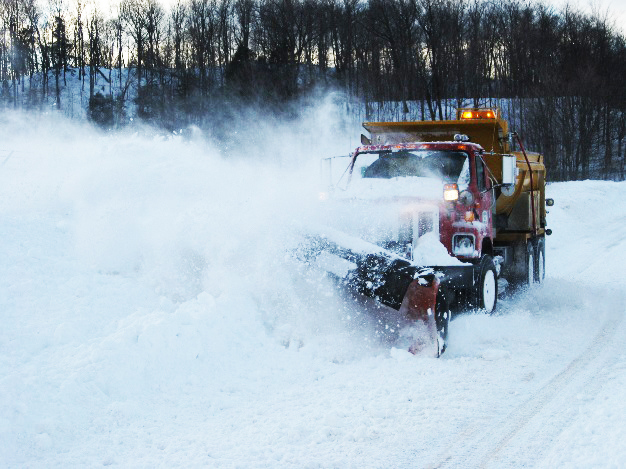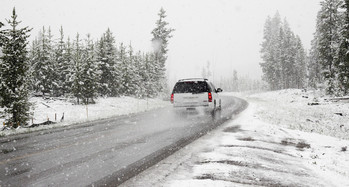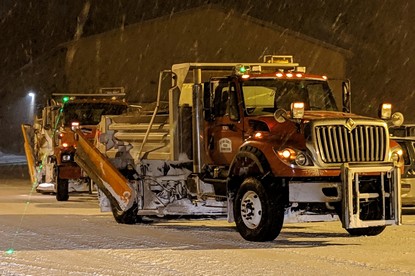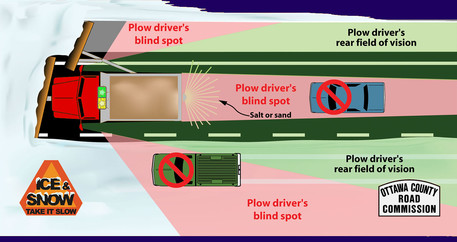|
December 2021 | Volume 11 | Issue 12 | 
|
|

Winter officially begins later this month, which makes it a perfect time to share how the Ottawa County Road Commission responds to winter weather.
Ottawa County snowstorms can last 24 hours or more, which means a lot of work is required for roads to return to a drivable state.
And then add the wind and drifting snow. All of this causes plow and salt truck drivers to work long shifts, up to 16 hours, in the worst of conditions.
Our crews monitor the weather 24 hours a day, seven days a week during the winter. They use an array of tools including radar and several professional weather services. Our staff also have tools to monitor pavement surface temperature and weather conditions across the county thanks to roadside weather sensors installed at key road and bridge sections.
All of this data allows our maintenance staff to allocate crews, as well as make important decisions such as how to best manage the use of road salt and other de-icing agents. The use of these de-icing agents requires us to balance the need for traffic safety while also being conscious of environmental and financial concerns.
|

Our staff will respond to as many as 50 winter maintenance callouts during a typical winter season.
This results in the use of about 20,000 to 25,000 tons of salt and 14,000 to 18,000 tons of sand during a winter maintenance season.
The cost of winter maintenance can easily exceed $3.1 million annually depending on the severity and frequency of winter weather.
When winter weather hits, make sure you check our website, Facebook and Twitter pages for updates on our response.
Plowing Priorities
Winter maintenance operations are conducted in accordance with the established priority system based on traffic volumes, road classification, and location.
The priorities are as follows:
1 – State Trunklines (i.e. I-96, I-196, US-31, M-45)
2 – Multi-lane Primary Roads
3 – Primary Roads
4 – Local Paved Roads
5 – Subdivision Streets
6 – Local Gravel Roads
7 – Dead End Streets and Cul-de-sacs
|

A common question is "Why do snow plows have green flashing
strobe lights?"
The basic answer: to help our crews be more visible -- especially in wintry conditions with low visibility.
The green cone in the human eye is the most sensitive and has the longest wavelength. This means green lights appear brighter and can be seen from farther away than other colored lights. This makes them suitable for enhanced visibility in inclement conditions such as a snow storm.
If you see blinking or flashing green lights, they are coming from a county road maintenance vehicle.
Be sure to slow down, be vigilant and steer clear of the road work, but also take care to stay on the roadway.
|

Did you know: Icy road fatalities account for more deaths (3.6 times more) than all other weather hazards combined in the US.
To make sure you stay safe during winter driving, be prepared for the road this season by following these tips:
- Do not attempt to pass snow plow vehicles while they are plowing. Never attempt to pass a snow plow on the right.
- Do not crowd the plow! Plow drivers have limited visibility and they cannot see directly
behind their trucks. Please be aware that snow plow trucks may back up at intersections.
- Be sure your windshield and other windows are clear of ice and snow, washer fluids are full, tires have proper air pressure and tread, and your vehicle is equipped with essential emergency equipment.
- Posted speeds are for ideal road conditions. Michigan law requires motorists to drive at a “careful and prudent speed” in all conditions. Reduce speeds and increase following distances.
- Accelerate and brake slowly and avoid over-steering.
- Beware of ice patches and “black ice”. Bridges and overpasses freeze first.
- If your vehicle becomes disabled, be sure to use flashers and mark the vehicle so that it can be seen clearly by passing vehicles and snow plows.
- Avoid distractions such as talking on your cell or texting.
- Always wear your safety belt and ensure that all passengers are properly buckled, and children are in appropriate child-restraints.
|

The final version of the Ottawa County Road Commission 2022-26 Strategic Improvement Plan is now available on the OCRC website.
The SIP identifies the county's transportation assets and their condition, and indicates how the Road Commission plans to maintain and improve the overall condition of these assets.
The SIP provides a strategic blueprint from which OCRC can align funds and other resources to meet the objectives identified to improve, maintain, and preserve OCRC transportation assets.
The SIP highlights anticipated revenue sources, planned road and drainage improvements, expenditures for routine maintenance, traffic and safety, equipment, facility improvements, and operating needs.
|
|
|
|
Important Dates:
December 2, 2021 | 9 a.m. | Board Meeting
December 16, 2021 | 9 a.m. | Board Meeting
December 24, 2021 | Christmas (Observed) | Office Closed
December 31, 2021 | New Year's (Observed) | Office Closed
View Meeting Minutes & Agendas
|
|